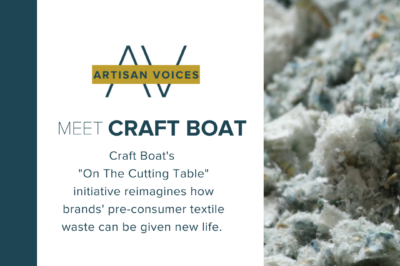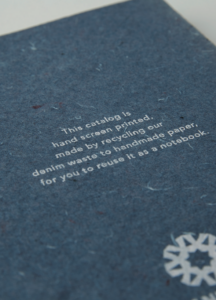Regenerative Seeds of Textile Waste

“As children, one of the first things we do with paper in our hands is craft a boat,” Priti Pugalia explained when asked about the meaning behind the name of her business, Craft Boat. While studying textiles, mainstream fashion, and manufacturing, Priti took notice of the textile waste falling from the cutting tables. This observation prompted the question of, “How do we streamline this process and the [cutting] table itself?”; thus beginning to plant the seed of Craft Boat. In 2015, driven by craft and sustainability, Priti founded Craft Boat – a business based in Jaipur, India that uses textile waste to create handmade paper and stationery products.
As ties to personal upbringing are reflected in the name’s meaning, Indian craft techniques and culture are reflected in the roots of Craft Boat; papermaking is a traditional craft of India. These traditional roots shine through the 45 artisans that the organization employs, most of whom are 3rd and 4th generation craftsmen and papermakers in the town of Sanganer, India. When asked about her approach to collaborating with artisans, Priti revealed, “I observe what they naturally have a knack for and try to enhance what they already enjoy. We all work together and share the load.”
The intersection of a strong, rooted cultural foundation and a regenerative approach has enabled Craft Boat’s seed to blossom. Through the introduction of new approaches and techniques, Craft Boat has been able to “close the loop and reimagine waste through a shift of form.” The intentionality of celebrating and honoring traditional techniques, while experimenting and incorporating new ideals, is illustrated within the organization’s four core pillars: craft & community, circularity, analog, and flow.

Craft Boat’s regenerative process begins by shredding the textile waste, even the smallest of bits, into even smaller pieces in preparation for them to be converted into pulp. “We once had 500 sacks of cotton fiber textile waste sent to us. Circles had been cut out of the fabric as it was used to produce makeup remover pads,” noted Priti when sharing an example of the type of waste they receive. After the small bits of textile are converted into paper pulp, they are then pressed into sheets. The amount of pulp within the sheets is intentionally measured and examined to ensure accurate grammage of the paper. Craft Boat creates their handmade paper products to result in various thicknesses (think card stock paper vs computer paper!). The pulp is then sieved to make sheets of recycled textile paper, a similar process to that of sieving flour to make dough. Since 2015, Craft Boat has recycled over 1,350 kg (2,976 lbs) of textile waste through this regenerative design process. A visualization of the process is captured through Craft Boat’s video below.
The organization’s “On The Cutting Table” initiative reimagines how brands’ pre-consumer textile waste can be given new life. Craft Boat purchases textile waste from design brands to then transform the company’s scrapped fabric into recycled paper and paper products, specifically hang tags. Why hang tags, specifically? When asked this question, Priti reflected, “While finding meaning to the waste, we observed that tags are the first touchpoint of the garment, apart from the garment itself. The purpose of hang tags goes beyond only containing the brand name and price, but has a space where brands try to echo their story and message that can sometimes bring the consumer behind-the-scenes. I thought the most vital areas for fashion brands to use recycled paper from their own pre-consumer textile waste would be the hang tags.”
In this initiative, brands purchase the hang tags back from Craft Boat, creating a circular, sustainable approach to their waste. The first company that Craft Boat partnered with was 11.11/ eleven eleven, a handmade clothing brand working with small-batch production alongside artisan groups across India. Through word-of-mouth and story-sharing on social media, Craft Boat has increased the project’s impact to now encompass ten “On The Cutting Table” projects with brands across the globe. “The possibilities are much more than just hang tags, but I feel the hang tag is a vital space in the ocean of the fashion industry and can slowly create a larger message for ‘On the Cutting Table’,” Priti added to her reflection.

“When a brand sends us waste, we usually ask that they separate their waste by color. We keep the final paper product the color of the waste itself,” Priti clarified when discussing the dying process for the “On The Cutting Table” initiative. For their consumer paper and stationery products, Craft Boat utilizes natural dyes – natural dyes extracted from turmeric, for example.
“I do believe nothing beautiful grows smooth. The right amount of push, force, hunger, and passion is required to make a seed germinate and open itself into a small plant, a fresh something, absolutely untouched and unaware.” Priti penned this beautiful quote during the first year of Craft Boat, and it still encompasses the inspiration behind the intentional work of the organization. “My inspiration for Craft Boat hasn’t changed over these seven years. It has only become more formed and has grown deeper,” Priti noted.
As the inspiration has remained consistent, Craft Boat’s business strategy has evolved this year through the planting of a new seed, Anaar. This new fruit of Craft Boat [Anaar], a consumer-facing curated collection of handcrafted products by the artisans of Craft Boat, brings a new team member to the business, Swati Pugalia. When asked how working alongside her sister since April has been, Swati mentioned, “Working with Priti is no less than a pleasure because I am a person who wants to be in my comfort zone and with her I’m in my comfort zone. Working together, we can both emerge and she helps me explore in a more beautiful way. I feel so comfortable and the flower [of Anaar] will bloom beautifully because of that, and because of the understanding we have. I’m moving with her, I’m rowing the boat with her.” In conversation, one can feel the passion that both Swati and Priti have for this work and the bond they have as sisters. Priti responded, “As beautifully ironic as Swati wanting to be in her comfort zone, I’m the person who’s wanting to push her out of her comfort zone. We’re here to lift each other up and we are giving back to what we’ve both learned from our family. Moving toward a single goal that we both have as humans, aside from craft, is that we can touch people in their lives.”
Intentional, cultural and familial roots are wonderfully intertwined throughout Craft Boat – from its founding to its present day. The meaning of the name, Craft Boat, exemplifies these roots. As shared earlier, personal upbringing is reflected in the name’s meaning through crafting boats from paper as children. Priti elaborated on this, “So the word ‘boat’ made sense to me, and is quite symbolic to a lot of things I believe in. Being on a journey and not really seeking to be in one place. Looking at the desired outcomes in life, but mostly looking at the journey and process that we follow.”

Follow Craft Boat’s journey and process @craftboat.
Interested in learning more about “On The Cutting Table”? Take a look at this informative video from Craft Boat.
The Artisan Voices blog explores the histories, experiences, pivotal moments, and innovative initiatives in an artisan or maker business while celebrating craft, community, and culture.